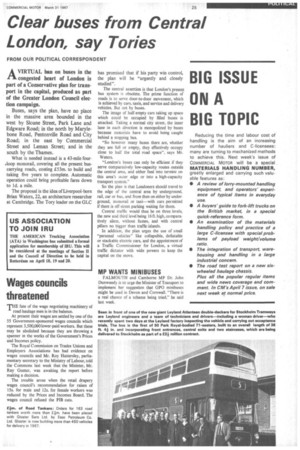Clear buses from Central London, say Tories
Page 27

If you've noticed an error in this article please click here to report it so we can fix it.
FROM OUR POLITICAL CORRESPONDENT
AVIRTUAL ban on buses in the congested heart of London is part of a Conservative plan for transport in the capital, produced as part of the Greater London Council election campaign.
Buses, says the plan, have no place in the massive area bounded in the west by Sloane Street, Park Lane and Edgware Road; in the north by Marylebone Road, Pentonville Road and City Road; in the east by Commercial Street and Leman Street; and in the south by the Thames.
What is needed instead is a 43-mile fourrloop monorail, covering all the present buscarrying roads, costing £53m. to build and taking five years to complete. Automatic operation could bring profitable fares down to id. a mile.
The proposal is the idea of Liverpool-born Brian Waters, 22, an architecture researcher at Cambridge. The Tory leader on the GLC has promised that if his party win control, the plan will be "urgently and closely studied".
The central assertion is that London's present bus system is obsolete. The prime function of roads is to serve door-to-door movement, which is achieved by cars, taxis, and service and delivery vehicles. But not by buses.
The image of half-empty cars taking up space which could be occupied by filled buses is attacked. Taking a normal city street, the inner lane in each direction is monopolized by buses because motorists have to avoid being caught behind a stopping bus.
"So however many buses there are, whether they are full Or empty, they effectively occupy close to half the total road space", says Mr. Waters.
"London's buses can only be efficient if they serve comparatively low-capacity routes outside the central area, and either feed into termini on this area's outer edge or into a high-capacity transport system."
So the plan is that Londoners should travel to the edge of the central area by underground, rail, car or bus, and from then on either by underground, monorail or taxi—with cars permitted if there is off-street parking waiting for them.
Central traffic would thus be on three levels, the new and third level being 16 ft. high, comparatively silent, without fumes, and with central pillars no bigger than traffic islands.
In addition, the plan urges the use of small "personal vehicles" like collapsible, defiatable or stackable electric cars, and the appointment of a Traffic Commissioner for London, a virtual traffic dictator with wide powers to keep the capital on the move.
















































































































